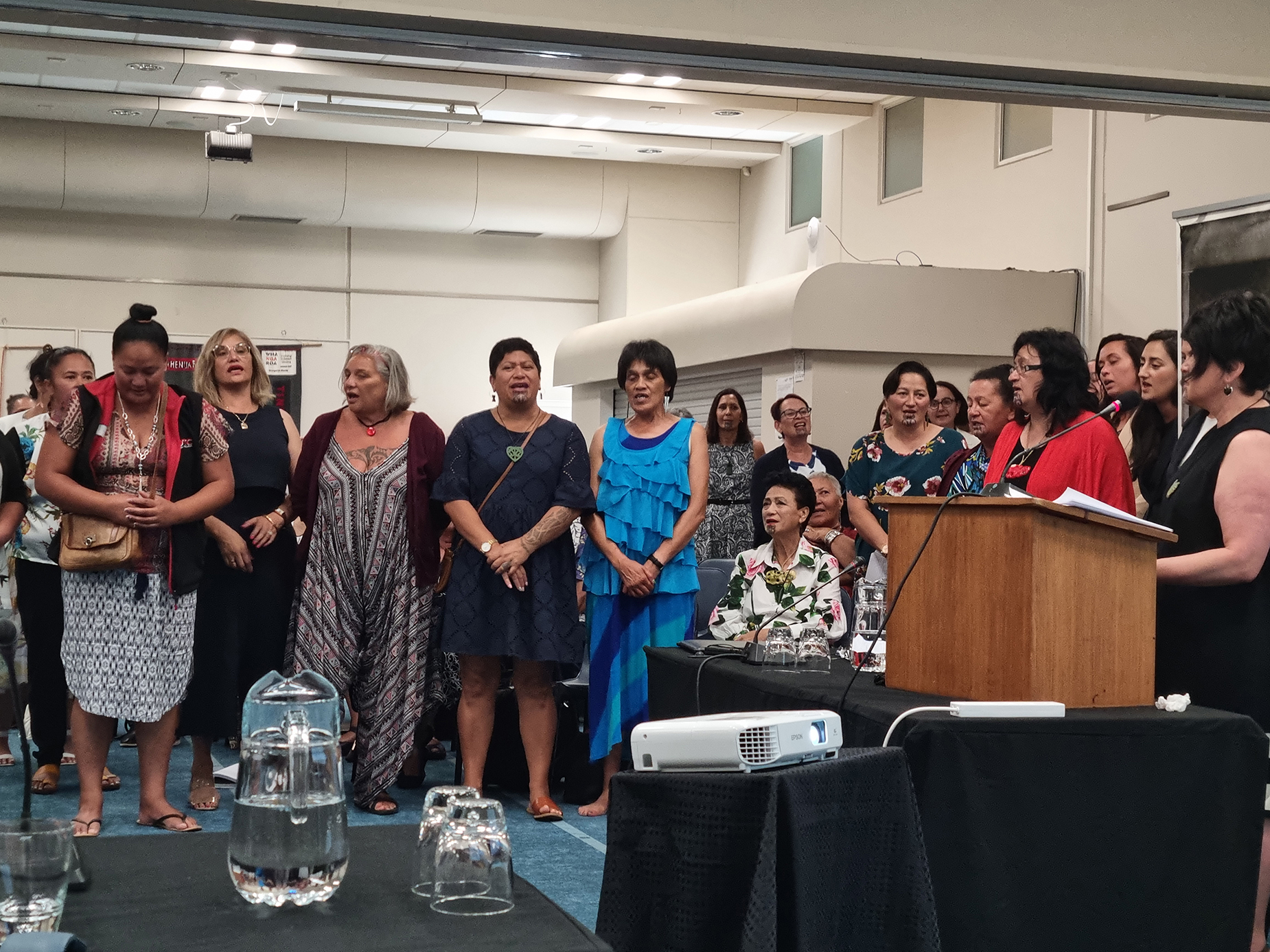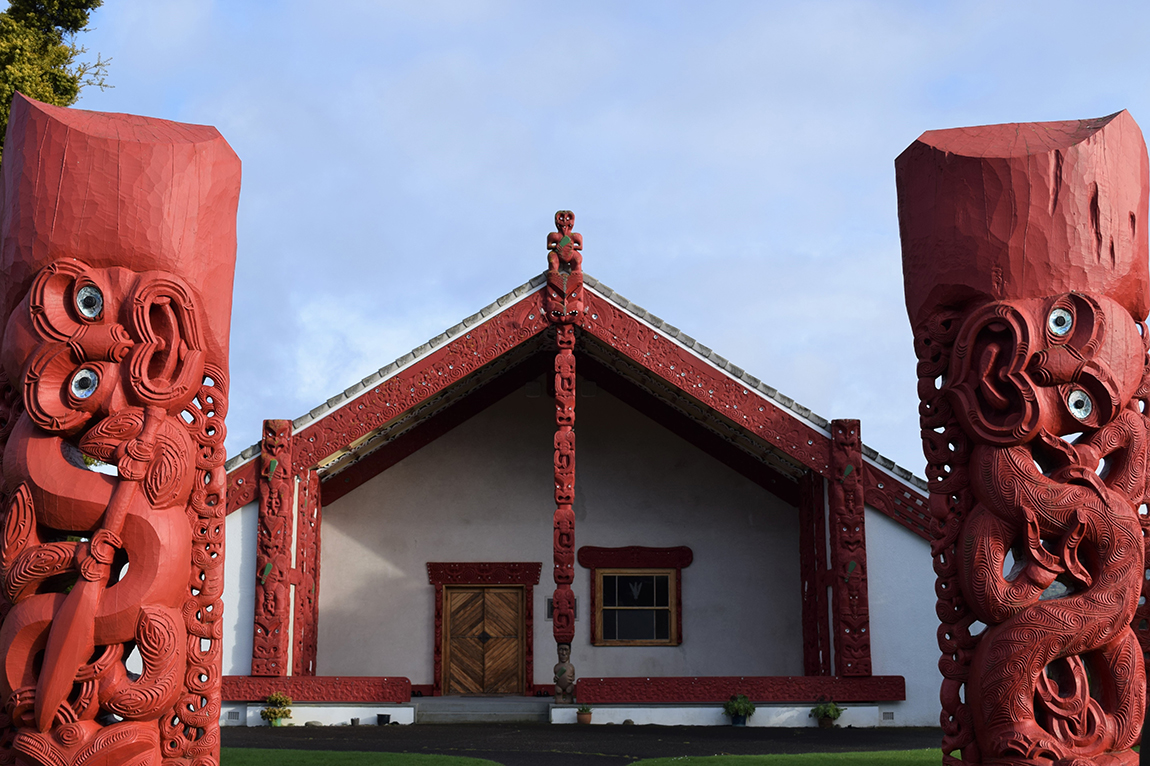Key tikanga concepts and their relevance to wāhine and tāne
Ko ngā tikanga matua me ō rātou hono ki ngāhuatanga o te tāne me te wāhine?
Tikanga is the system of law underpinning traditional and contemporary Māori life and informs the roles played by tāne and wāhine in te ao Māori. Although many aspects of tikanga are relevant to the lives of wāhine, witnesses in the tūāpapa phase of the Mana Wāhine Kaupapa Inquiry primarily spoke about tapu, noa, mana, and utu.
Read what witnesses said about:
- Tapu and noa;
- Mana; and
- Utu.
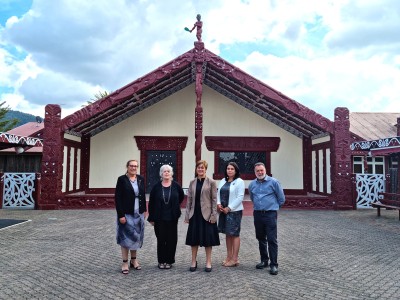
Mana Wāhine inquiry panel outside Tūrangawaewae Marae, February 2021
Tapu and noa
Tapu and noa were integral to everyday life in pre-colonial Māori society, shaping relationships between tāne and wāhine and the balance between the spiritual and everyday realms. Tapu and noa impact many everyday activities in Māori life, including food, birth, and death. Witnesses described tapu as encompassing both power and constraint, implying prohibition and separation from everyday life. In contrast, noa represents an unrestricted state.
Witnesses challenged the idea that tapu is associated with male power and male spheres of activity, while noa is associated with wāhine. Witnesses emphasised that wāhine Māori can embody both tapu and noa. For instance, during times of menstruation, pregnancy, and childbirth, women are considered very tapu, but at other times they also possess the power to whakanoa, to cleanse and uplift individuals from states of tapu. Similarly, food is often associated with tapu, but women’s involvement in food production establishes their influence over tapu resources. This ability of wāhine to transition between the states of tapu and noa, witnesses explained, showed the power of wāhine to enable life to continue.
Key witnesses who gave evidence
Professor Leonie Pihama (doc A19) explored how tapu and noa have been interpreted by Pākehā ethnographers, such as that of Elsdon Best, as well as in more recent academic literature, particularly the work of Manuka Henare. She explained how Best positioned tapu and noa in ‘negative opposition’ and regarded wāhine as ‘destroyers or polluters of tapu’. By contrast, she said Manuka Henare locates tapu and noa as co-existing forces that are not in opposition. In his view, tapu is ‘potentiality for full realisation; to have influence, to evolve, to control, that is to be more Maori, more human’, while noa is ‘“freedom” from tapu and “normality”’. Professor Pihama said that this concept of noa ‘locates the process of whakanoa as one that works to prevent the extension of tapu to people, rather than one that opposes intrinsic tapu’. As such, wāhine are not ‘polluters’ but play an essential role in maintaining balance between tapu and noa.
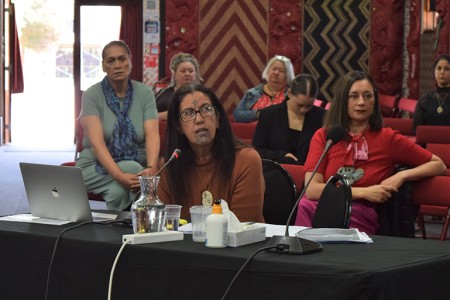
Professor Leonie Pihama giving evidence at Ngā Hau E Whā, Christchurch
Dr Ella Henry (doc A63) summarised ethnographic records of tapu and noa in Māori society, including from Jørgen Prytz Johannsen (1911-1989), a Danish scholar who wrote about te ao Māori. Dr Henry said that according to ethnographic scholars, ‘Tapu was, and is, synonymous with prohibition, and separation from the realm of day-to-day living’ and ‘has increasingly come to be associated with male power’. [Jørgen Prytz] Johannsen observed that: ‘Among the Māoris woman is the great representative of everyday life; according to her nature she is noa as the man is tapu.’ However, Dr Henry said ‘increasingly noa has come to be translated as: common or profane; rather than the more accurate translation of noa as a liberating force, an example of woman’s power’. She cited archaeological evidence from Ruapuke Island that indicate that ‘food and cooking utensils were present in dwelling and sleeping houses in the 1820s. Thus, the prohibitive relationship between food and tapu may well have been confined to the male sphere of experience and knowledge, rather than being a constraint on both men and women. Given the importance of food to the community, one could view the tapu associated with food as a means of empowering and enshrining women’s access to power and control of food resources, for those who control food production and processing are extremely valuable and valued in any society’. Dr Henry also noted that ‘[Jørgen Prytz] Johannsen, in his discussion of menstruation, offers a reason why Māori women are considered noa. When she is menstruating she is very tapu for a specific period, and this may be the reason why, at all other times she is noa. Thus, women are attributed with both sources of power, tapu and noa, whilst men must call on women to free them from the prohibitions of tapu’.
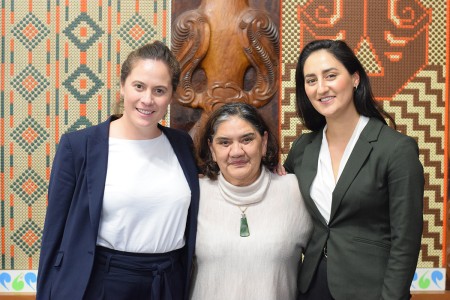
Dr Ella Henry pictured with her lawyers Natalie Coates (left) and Tara Hauraki (right)
What witnesses said about tapu and noa
- “Tane: embody tapu, tapu roles, protection, karakia, korero and mahi tapu such as construction, carving and warfare as required … Wahine: embody noa, whare tangata, birth, death, kai, karanga / te reo tuatahi o te whare, te timatanga o te huihuinga, whakapapa and whenua / connection between ira tangata and land / a place to belong. Wahine, as whare tangata tapu, are the creators, nourishment and builders of ira tangata. Te u kaipo – the first and last nourishment of the child / tangata.” (Aorangi Kawiti, doc A24(a), pp 5-6)(external link)
- “The role of whakanoa is crucial to the role of whakatupu / tapu. Tapu needs noa to bring the balance of life back to the state of common and everyday so that every day activities can be carried out. Kai, wai, karakia, haka and waiata bring noa, often used in combination to remove tapu from formal and sacred activities, objects and people.” (Aorangi Kawiti, doc A24(a), pp 5-6)(external link)
- “Te Tapu O Te Tangata is the being of tangata having sacredness, dignity and value by virtue of their relationship with Atua / atua, and whenua. All people have tapu.” (Hana Maxwell, doc A69, pp 5-6)(external link)
- “Any violation of tikanga diminishes the tapu of the victim, the perpetrator and their links. Violation disempowers tangata because violation blocks and renders mana ineffective. All are in a state of noa – a state of weakness and powerlessness. A person left in this position does not have the mana to free themselves from the position of noa. Goals cannot be imagined nor mana achieved. As a consequence of diminishing tapu and mana, tapu restrictions are no longer effective in restricting access and prohibiting violation. Tapu becomes more vulnerable to violation.” (Hana Maxwell, doc A69, p 7)(external link)
- “The concept of inter-relationship and balance can be seen for example in the fact that women can be both tapu and noa. For example, women are considered very tapu during menstruation, due to the degree of tapu associated with blood. However, the presence of women was also seen as a potent form of whakanoa. One example of this is when warriors returned from war they would crawl between the legs of a woman to whakanoa themselves from the killing and bloodshed, which had rendered these men tapu.” (Kayreen Tapuke, doc A94, p 3)(external link)
- “For Māori women, their bodies were treated with the utmost tapu during the times of menstruation, pregnancy, and childbearing.” (Violet Walker, doc A66, p 5)(external link)
- “Tapu and noa concepts drove the functioning of everyday living and ensured that spiritual balance was related to survival and safety of the community. Tapu and Noa can be likened to right and wrong, clean and unclean, safe and unsafe. This is definitely my view.” (Violet Walker, doc A66, p 11)(external link)
- “Tapu and noa, tane and wāhine, yin and yang – in life there is balance where one cannot exist without the other. These properties are not in competition with each other but rather complementing each other and each having their own role to play in the world.” (Lee Harris, doc A23, p 3)(external link)
- “All things are deemed Tapu in Te Ao Māori because they all originate from Io. Because of these origins Nga Mana Tuku Iho is passed down to te ira tangata / te ira tāne.” (Paihere Clarke, doc A141, p 2)(external link)
- “Wāhine Māori were believed to bring balance to some of the rituals and practices. One in particular was the process of whakanoa, which occurred after wars. This was the process of cleansing, or uplifting the sacredness of that realm, being Tumatauenga, the God of War, to ensure the men would return home from war, and not have to carry the heaviness and burdens of that war. This role came with a lot of mana and responsibility, and was a very tapu ritual, only to be carried out by these carefully selected wāhine rangatira, hence restoring and protecting the wellbeing of the whānau, hapū, and iwi.” (Paihere Clarke, doc A141, p 7)(external link)
- “When something was tapu, sometimes you had to have the men to go and uplift the tapu (whakanoa), before the women touched it. For example, when you open a whare, from way before, the women had to do all sorts of things because they were tapu. But because of the tapu of the whare, only the tāne could open the whare. This was because they had to protect the women, and the women could only come in at a certain time. The tapu for me was about protecting the whenua and whakapapa, and that was only enabled by the wāhine.” (Paihere Clarke, doc A141, p 8)(external link)
- “Tapu in relation to wāhine is mainly related to her whare tangata. So, when a woman has her period or is hapū, she is tapu. Tapu and manaaki are therefore reliant on a monthly cycle. It dictates when tāne and wāhine can do the mahi that needs to be done.” (Robyn York, doc A65, pp 7-8)(external link)
- “The status of Māori women in pre-European society was bound up in tribal and hapū laws and protocols. Women were regarded as ‘noa’ or ‘tapu’ and certain practices were observed to maintain that status. For example, a pre-pubescent girl could sanctify a house by walking through it before anyone else.” (Tania Rangiheuea, doc A22, p 4)(external link)
- “The sacred role of wahine in the negotiation of states of tapu and noa is also referenced in our wharenui, through their placement on pare (lintels) above doorways so that, through passing beneath them to enter the whare, we are made safe for our discussions and learning. … Further acknowledgement of the mana of wahine by carvers includes the presence of wahine along the rauawa (side strakes) of waka taua, the spiritual function of which would be to aid in the transition of tapu and noa for those travelling on the waka.” (Tina Ngata, doc A88, pp 9-10)(external link)
- “The transitioning between states of tapu and noa is fundamental to spiritual safety within Te Ao Māori … wahine, with their specific roles in overseeing the most paramount transitions between this world and the afterworld (that being birth and death), gave them particular spiritual relevance and authority in this context.” (Tina Ngata, doc A88, p 10)(external link)
- “One of many roles of wāhine is to whakanoa people, places and things. She does this with the Mana and Tapu that she holds therein nurturing and protecting the hapū. When our men returned from war to lift the tapu of the blood that they shed they would crawl between the legs of a ruahine making them noa. Additionally, to break them out of their war stance, Nguha woman would have intercourse with these warriors to bring them back into a balanced state. The sexual power and force that wāhine hold was one of the many sacred roles.” (Paula Ormsby, doc A55, p 17)(external link)
- “Women were treated as the ultimate tapu because of their ability to enact noa.” (Moe Milne, doc A62, p 21)(external link)
- “[T]he wāhine of Tūhoe have a very important role and responsibility of lifting the tapu of the whare wananga. Tino mahi nui ko te whakanoa. This role is very important. This is because a man cannot do this.” (Materangatira Lily Porter, doc A16(a), pp 2-3)(external link)
- “Given the importance of food to the community, one could view the tapu associated with food as a means of empowering and enshrining women’s access to power and control of food resources, for those who control food production and processing are extremely valuable and valued in any society.” (Dr Ella Henry, doc A63, p 11)(external link)
Mana
The crucial concept of mana was discussed by many witnesses in the tūāpapa hearings of the Mana Wāhine inquiry. They emphasised that mana is inherent to every individual and derives from connections to the atua and whakapapa. Mana is maintained through collective relationships. Witnesses said that both wāhine and tāne have mana, but the mana of wāhine is reinforced through their authority over whakapapa as possessors of te whare tangata.
Key witnesses who gave evidence
Keri Opai (doc A118) told the Tribunal that the Māori language inspires and uplifts the mana of women. For instance, many Māori terms are gender neutral, including pronouns and ancestral names. Similarly, language rules do not require different ways of referring to male or females of the same generation. He concludes this means the mana of men and women was not considered differently in pre-colonial Māori life.
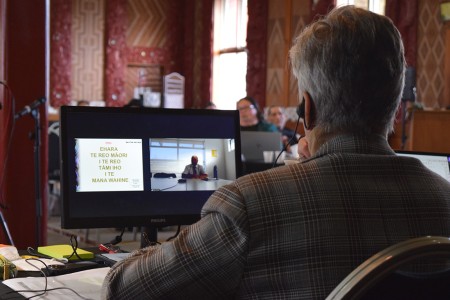
Keri Opai giving evidence virtually, pictured with Judge Sarah Reeves
What witnesses said about mana
- “My mana does not originate from yester-year. It is mana originating from the ancient times of the creation of the world. Mana is a manifestation of one’s voluntary dedication, commitment, and sacrifice for the betterment of one’s peoples with no expectations of being compensated, but rather a deed of good faith and goodwill.” (Paihere Clarke, doc A141, p 2)(external link)
- “Central to Mana Wahine is the concept and practice of ‘mana’. The meaning of ‘mana’ is one that engages us conceptually, culturally, spiritually, emotionally and in material ways of being, and encompasses an essence and power of being that we have been reminded is beyond any singular translation. Mana is multi-dimensional and requires an understanding of wider tikanga Māori and the relationships within which we locate ourselves. Mana is connected to every form of activity within Māori society and is generated through collective relationships. Mana is also enhanced by the collective in order to support people’s role in fulfilling particular obligations, social and political functions, as such it is a significant contributing factor to the how we present ourselves and are seen by others. In the context of discussing Māori women’s theories, mana relates to notions of power, status and collective affirmation of our place within our communities. Mana is both inherent to our being as Māori and can be enhanced or diminished through the ways in which we enact ourselves within the collectives that we affiliate to and with. Mana is therefore connected to both spiritual and earthly sources. Rangimarie Rose Pere reminds us that the origins of mana is firstly that of our connections to atua. This affirms the sacredness of all people.” (Leonie Pihama, doc A19, p 7)(external link)
- “It is within [whakapapa] relationships that mana is embedded, and it is through our relational being with each other that mana is enhanced or diminished. This includes how we operate and move within these cultural relationships. Mana is both tangible and intangible. It is both internal and external. It is both relationships with others and being in relation with ourselves, our fundamental ways of being in the world and our treatment of others. Mana can be understood in both its simplicity and its complexity. Simply put, all Māori people have mana, however with the impact of colonial invasion and on-going structural oppression on Māori lands we know we must engage more deeply when we speak or write of mana, and in particular of Mana Wahine.” (Leonie Pihama, doc A19, pp 9-10)(external link)
- “Mana has come to be associated with prestige, power and status. But it also has an esoteric quality, giving it a significance which ensured the word was not used lightly until more recently. Mana was vested in the chief, which gave that person status and power, but the autonomous relationship between the chiefs and their tribe acted as a constraint on the power of the chief, especially in regard to the expectations which a chief could impose on the tribe. Though chiefs maintained the mana of the iwi, or hapū, each individual member of the tribe retained a high degree of autonomy. Thus, a chief was not free to behave in a dictatorial or autocratic manner.” (Ella Henry, doc A63, p 10)(external link)
- “Women are life-givers, and world creators, and derive their mana and authority from this role.” (Angela Wanhalla, doc A82, p 5)(external link)
- “Mana relates to wāhine in the same way as anyone else. Each person is responsible for their own mana. One cannot take someone else’s mana. There are things that one can do to diminish their mana. My aunty, Robyn, can lose her mana, but I cannot take it from her. One can only do things to oneself that diminish mana.” (Violet Walker, doc A66, p 4)(external link)
- “Mana was displayed in the hosting of visitors. Preparing a sizeable banquet showed the visiting tribes how much mana the hosting tribe possessed. The contributions of wāhine Māori were essential for this display. If the hospitality was good and the visitors were well fed, that is what they took with them.” (Violet Walker, doc A66, p 8)(external link)
- “One way of looking at mana is leadership and decision-making for the hapu. You have to have whakapapa and ahi kaa to carry mana in the context of being able to make decisions for us here at home. Women have been central to this.” (Tracy Hillier, doc A92, p 16)(external link)
- “Mana is everything: it is my life force and connection to my tupuna.” (Robyn York, doc A65, p 7)(external link)
- “[W]omen were accorded mana through their actions and behaviours in addition to their inherited mana, in much the same way as men were.” (Tina Ngata, doc A88, p 6)(external link)
- “Mana denotes many things, such as a power and authority which is endowed by a higher order i.e. from spiritual gods to mortal beings … Mana is also expressed as a social contract between the leaders and the tribe. [Hirini Moko] Mead points out that every individual is born with mana i.e. they possess a personal mana. He coined the term ‘kaihau-waiū’, which metaphorically describes this birth right of every child that is gained from their mother’s breast milk. … A child can also inherit mana based on the deeds, social standing or regard that others have of their parents. An individual’s achievements can enhance not only their personal mana but also the mana of a collective i.e. their whānau, hapū, or iwi.” (Tania Rangiheuea, doc A22, p 4)(external link)
- “Mana, by its very nature is what another person / entity believes, perceives and conceives of that person / entity. That would be the role of Māori – wahine and tane. Whether uri are tane or wahine, our whakapapa gene pool and inherited rights are gifted to us without prejudice. We may carry various similar and dissimilar roles. Mana rangatira is inherent in us all.” (Aorangi Kawiti, doc A24(a), p 8)(external link)
- “Ko te kupu Mana he taonga i tukuna mai e nga tīpuna ki a koe. Ka whānau mai te tamaiti ki tēnei ao ka whānau mai ia me tōna mana motuhake. Ko tēnei mana motuhake i whakawhiwhia mai e ōna tīpuna me ngā atua. (Dr Hiria Hape, doc A114, pp 31-32)(external link)
- “Ehara te reo Māori i te reo tāmi iho i te mana wahine, otirā, māku e taukī atu i konei, he reo hiki, he reo hāpai, he reo whakatairanga kē i te mana wahine. (Keri Opai, doc A118, p 2)(external link)
- “We must not forget however, that we all came to this world through women. Mana tangata is through women.” (Anne Rotorangi-Kendall, doc A36, p 8)(external link)
- “All mana is sourced from the atua/gods. Ranginui is our Sky Father and Papatūānuku is our Earth Mother. For Māori wāhine, the sources of this mana (mana wahine) include te ara uwha o Tahu (the heavenly female path of Tahu), the primal parent Papatūānuku and other female deities.” (Te Amohia McQueen, doc A52, p 4)(external link)
Utu
Various witnesses discussed the importance of utu in te ao Māori, describing it as an example of restoring balance and seeking justice. Muru, the call for utu, was said to be often instigated by women.
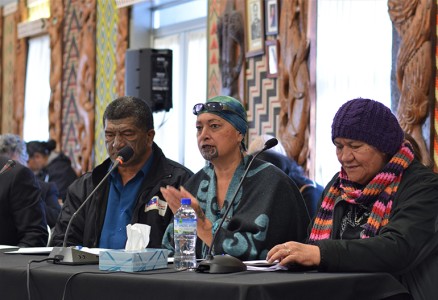
From left: Bryce Peda-Smith, Violet Walker, Robyn York
What witnesses said about utu
- “Inter-tribal conflict was believed to have been relatively common, particularly with the increasing fortification of tribal communities from the 14th century. Intra-tribal warfare was also presumed to be at least as common, no doubt because of the types of offences which could occur. With the sanction of custom, one party could attack and plunder another under the umbrella of utu. Even the seeking of utu, through conflict, was ritualised by set patterns.” (Ella Henry, doc A63, p 26)(external link)
- “Balance is emphasised in restorative justice. Where a child of one family was killed, the family of the killer would offer a child to the victim’s family. It was in the interest of the killer’s family to offer a replacement child. We would have gone to war and wiped the whole lot of them out if they did not collectively atone. On the other end of the scale, chiefs of each hapu would engage in korero with their counterparts where members of hapu intrude onto and take kai from the rohe of other hapu.” (Violet Walker, doc A66, p 10)(external link)
- “If a person did something wrong, they might experience mākutu as a result. This was when the utu would start. Mākutu was used in the old days to discipline a person but also to ensure that others do not follow their example. In the old days, people could identify when someone had done something wrong because the behaviour of the person changes. A lot of Māori can pick up what is happening, and they would go straight to a tohunga. My nana used to remove mākutu. I remember that most Māori could use mākutu. The mamae was usually caused by jealousy, greed, or other things that occur in life.” (Materangatira Porter, doc A16(a), p 9)(external link)
- “In traditional society, our tupuna would have dealt with any wrongdoing, especially in relation to violence amongst or against the hapū and whānau. The whānau and hapū would have dealt with any issues between themselves. It was about retaining the balance, known as muru and utu.” (Robyn York, doc A65, p 8)(external link)
